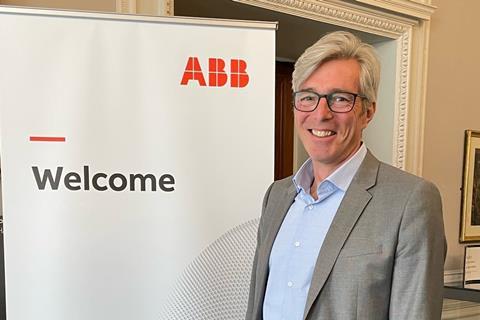Christoph Rofka, Senior Vice President, Medium & Low Speed and Rail, ABB Turbocharging, hinted at a step change in low-speed turbocharging in a recent interview with The Motorship.
Speaking on the sidelines of a press conference in central London in May, Christoph Rofka, Senior Vice President, Medium & Low Speed and Rail, ABB Turbocharging outlined a number of exciting initiatives for the turbocharger and technology supplier.
The most ‘eye catching’ initiative was a new approach towards low speed turbocharging, which ABB Turbo plans to unveil at the next CIMAC conference, which will be held in 2023.
The solution relates to a change in how the turbocharger is applied on an engine. “By challenging conventional ways in which turbochargers are installed, we have seen a lot of potential.”
Rofka noted that the individual turbocharger itself would look quite conventional. “We have made progress improving the efficiency to weight ratio to make the turbocharger more compact, but that was something that we had already done with the previous generation.”
The solution was expected to lead to significant improvements in efficiency, but Rofka noted that he was unable to elaborate further at this stage.
Rofka noted that he expected that the development of the solution would be well advanced by the middle of 2023. Rofka added that ABB was planning to bring the new turbocharging concept to market by the end of 2024.
Modular design concepts
The new design extends ABB Turbocharging’s modular approach towards turbocharger design.
Currently, individual components within the turbocharger, such as the turbine stages or compressor stages, are being designed toward generic values – such as higher efficiency, lighter weight, and greater compactness – and can be introduced into the turbocharger design platform to improve performance as component level advances occur.
Redesigning the turbocharger to permit easier service access appears to have coincided with advances in the reliability of the unit itself. “The substantial improvement in the reliability of turbochargers over the last 10 to 15 years.”
However, the turbocharger itself was likely to have been redesigned to reduce the amount of time required to exchange the central cartridge in the unit.
Rather than requiring an overhaul during every dry dock, or extended port stay, the new solution could see more flexibility in when an overhaul needs to be done and the time required to carry out the overhaul shortened.
“I would expect the next generation [of turbochargers] to be able to exchange the core of the unit during every regular port stay. This naturally leads on to quite new ways of service and maintenance models.”
Rofka agrees readily that the new service models that ABB Turbocharging has begun to offer are being made possible by improvements in the data that it gains into the performance of its turbochargers.
“We have recently launched a product where we connect our turbochargers from running hour zero… we have also recently launched Turbo MarineCare, which offers customers a warranty from drydock to drydock based on the evaluation of operational data”.
The first solution offers basic connectivity from day one, providing very basic engine performance data and turbocharger performance data. In return, ABB will have access from day one. This will allow us to develop more attractive offerings for the life cycle, as we will know the operation history of all of our turbochargers in the future, which will allow us to assess the health condition of the equipment. Our service agreement Turbo MarineCare seamlessly connects to this from running hour zero providing a life-long equipment warranty.
“At the end of the day, it will be a little like turbocharging as a service,” Rofka says. “We know the data, we know how the turbocharger has been operated, we know best when to make the best service.”
This links up with the possibility of servicing the turbocharger during each port stay. “This will be offer enormous flexibility for our customers. And we have a huge service network to facilitate.”
The development was one of the first products of a new product development approach that had been adopted by the company’s engineers, which has seen the company move away from highly descriptive product requirements towards a directional set of requirements.
“Instead of several pages of requirements, we gave our engineers four or five bullet points… The result has not been the result of a strategic decision, but rather the result of challenging designers to take really big steps and assume more risk, rather than focusing on iterative improvements.”






